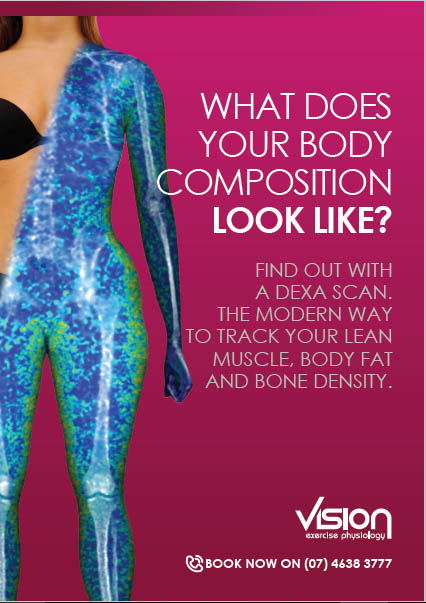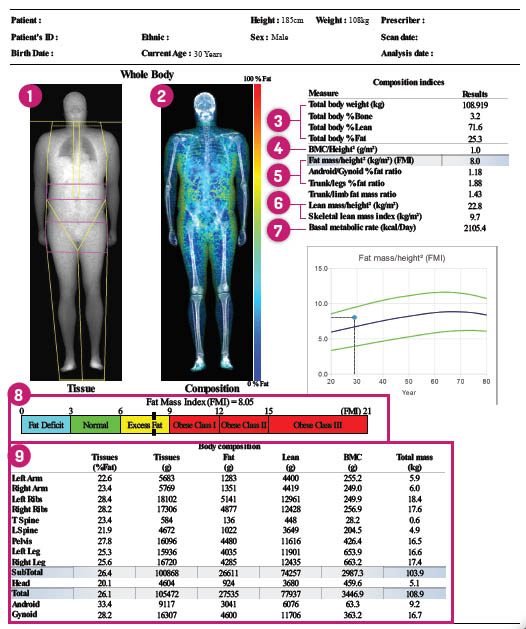DEXA (dual energy X-ray absorptiometry) is one of the most accurate methods for measuring body composition.
As the name implies, two different energy levels of x-ray pass through your body and measure how much fat, muscle, and bone you have. A DEXA scan eliminates the guesswork and provides you with specific details about how much and where fat and muscle are situated on your body. If you’re a regular gym goer, athlete, or just starting to get back into shape, a high-resolution DEXA scan is just what you need to track, trend, and benchmark your results.
DEXA Scan Service
- Full Body Composition Analysis
- Bone Mineral Density (BMD) Scans
- Leg Length Scans
Why should you get a DEXA scan?
- Find out exactly how much fat and muscle you have
- Establish a baseline prior to a new exercise/diet program
- Monitor your muscle growth and body fat loss
- Get a more complete picture of your relative health risk
- Get meaningful data based purely on the amount and distribution of fat and lean mass in your body

What does getting a DEXA scan involve?
To have a scan, you’ll simply be asked to lie flat on the padded table while the arm of the machine passes over your body.
The scan only takes around 6 minutes!

Is DEXA safe?
A DEXA scan emits very low-dose x-ray beams, even less than a chest x-ray!
A DEXA Scan poses no significant health risk, and you would receive a similar amount of background radiation on a return flight from Sydney to Melbourne.
However, you should not have a DEXA scan if you’re pregnant, potentially pregnant, or if you’ve recently had any other more powerful imaging (such as an MRI or CT scan) with contrasts like iodine.
What can I do with the results of my DEXA scan?
A DEXA scan will give you a highly accurate baseline to help you achieve your goals. By knowing your body fat and lean tissue percentage, you can make lifestyle changes to improve your health and reduce your risk for various diseases.
The results of your scan, along with Resting Metabolic Rate (RMR) and VO2 testing, can also be used to recommend specific information on your ideal caloric intake and energy expenditure, helping you achieve your goals of fat loss or muscle gain quantitatively, virtually eliminating opinion based feedback.
By having your body composition monitored periodically, you will also be able to objectively track your progress towards goals. Quantifying these changes also helps with updating dietary and activity requirements. Feedback from DEXA scans can also be a powerful motivational tool for this purpose.

How often should I get a scan?
After your initial DEXA scan, you should wait at least two to three months before you have a follow up scan. This will ensure that you give your body enough time to experience detectable physiological changes in muscle and fat mass which can be picked up by the DEXA scanner.
What makes DEXA better than other body composition measurement methods?
DEXA is one of the quickest and most accurate and practical methods of body composition available. It addresses many of the limitations of other body composition methods. For example:
Hydrostatic or Underwater Weighing
Can be expensive, cumbersome, time consuming and impractical for most people with a busy schedule.
Skin-Fold/Calipers
The Skin-Fold, Caliper, or Pinch Test is a quick field measure for estimating overall body fat from subcutaneous fat (the fat just below the skin), but it does not give an indication of potentially dangerous visceral fat. Moreover, this method is highly susceptible to measurement errors.
Bioimpedance Analysis (BIA)
Bioimpedance Analysis (BIA) is common in many health and fitness centres and requires you to stand on a device that looks like a bathroom scale. BIA measures total body water and then estimates body composition, so the test results can be skewed by your individual hydration status.


